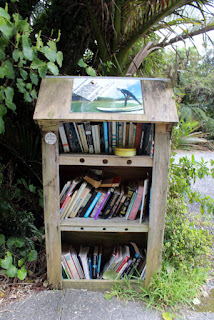How to Live in a Dying Town
 |
| The message that greets you in the Robert Harris coffee shop in Greymouth |
Timber was a big business too. On the West Coast there was an impenetrable rainforest just waiting to be logged out. And they did, using horses to pull the big trees out of the forest.
But that was nothing to what happened when the miners discovered coal - the black variety was more profitable than the much rarer glittery stuff. After the coal mining began, a railway was needed to connect up the mines, and a shipping port to ship it out. All that is left of the wharves today are the cranes - made in my home-town Carlisle in the UK! - and the odd bloke fishing for whitebait.
 |
| Cranes made in Carlisle, Cumbria - a long way from home! |
 |
| Dipping for Whitebait |
 |
| Shipwreck on the Greymouth Bar. Photo NZ Gov encyclopaedia |
A lot of the coal was shipped out across the Alps, through Arthur's Pass, by rail to the east coast port of Lyttleton, which was safer and easier. The port at Greymouth slowly died. The town became dependent on coal. But the seams were as dangerous as the port - producing a lot of methane and other gases. The mines were fraught with accidents. Most recently, the notorious Pike River disaster, where a series of explosions and fires rocked the mine killing everyone underground at the time. 29 men died in the tragedy and some bodies have never been recovered because it is too dangerous to go down.
 |
| Pike River Mine - the aftermath |
The Museum is an architectural gem - it has the feel of one of those fascinating antique shops that allow you to trawl through the bric-a-brac. There are rooms full of photographs and bits of wrecked ships, personal effects, and mining equipment.
I loved the old Greymouth switchboard.
And the diving suit and boots, dating from the early days of the port when divers in lead boots were winched down to salvage the wrecks.
 |
| Bank of New Zealand - A New Land |
Favourite thing? This roadside bookshop with an honesty box on the shelf!













Comments
Post a Comment